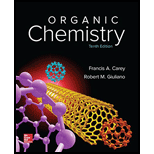
Interpretation:
The stepwise mechanism of the formation of
Concept introduction:
The reaction of methyl and primary alcohols with hydrogen halide mostly proceeds through
The reaction of tertiary alcohol with hydrogen halide proceeds through
The
The
Formation of carbocation is the rate determining step in
The nucleophile (halide ion) attacks on the electrophilic carbon from opposite side of hydroxyl group (i.e. backside attack) in
The position of leaving group in reactant and that of nucleophile in the product are same in case of
Want to see the full answer?
Check out a sample textbook solution
Chapter 5 Solutions
Solutions Manual for Organic Chemistry
- Following is a balanced equation for the allylic bromination of propene. CH2==CHCH3 + Br2 h CH2==CHCH2Br + HBr (a) Calculate the heat of reaction, H 0, for this conversion. (b) Propose a pair of chain propagation steps and show that they add up to the observed stoichiometry. (c) Calculate the H 0 for each chain propagation step and show that they add up to the observed H 0 for the overall reaction.arrow_forward5c) Write the rate equation for the following SN1 reaction:arrow_forwardThe reaction of 1-bromopropane and sodium hydroxide in ethanol occurs by an SN2 mechanism. What happens to the rate of this reaction under the following conditions? Q.)The volume of the solution in which the reaction is carried out is doubled.arrow_forward
- Explain the mechanism of the following reaction using photodissociation: HCOOCH3 + hv -> CO + CH3OHarrow_forwardThe reaction of 2,2-dimethyl-1-propanol [(CH3)3CCH2OH], also known by the common name neopentyl alcohol, with HBr is very slow and gives 2-bromo-2-methylbutane as the major product.Give a mechanistic explanation for these observations.arrow_forwardCompound A reacts with the reagents shown in the image. Write the mechanism, step by step, for the formation of product B. Note that B has the molecular formula C14 H18 O.arrow_forward
- The HCo(CO)4complex can catalyze the isomerization of pure cis-2-butene to a mixture of cis-2-butene, trans-2-butene, and 1-butene. Propose a mechanism. Carefully show the process using wedges and dashes to indicate stereochemistry of each intermediate.arrow_forwardGive the reaction mechanism showing all possible products for the following reactions: (a) Reaction of 1-propene with hydrogen bromide, HBr (g)arrow_forwardis steric hinderance not an issue here? why when reacting with KOC(CH3)3 does it yield 2-isopropyl-1-pentene and it yields 2,3-dimethyl-2hexene here?arrow_forward
- Compound A, C 10H 18O, undergoes reaction with dilute H 2SO 4 at 50 °C to yield a mixture of two alkenes, C 10H 16. The major alkene B, gives only cyclopentanone after ozone treatment followed by reduction with zinc in acetic acid. Which of the following reactions are correct. Can be more than one answerarrow_forwardFollowing is a balanced equation for bromination of toluene. (a) Using the values for bond dissociation enthalpies given in Appendix 3, calculate H0 for this reaction. (b) Propose a pair of chain propagation steps and show that they add up to the observed reaction. (c) Calculate H0 for each chain propagation step. (d) Which propagation step is rate-determining?arrow_forwardReaction of HBr with 2-methylpropene yields 2-bromo-2-methylpropane. What is the structure of the carbocation formed during the reaction? Show the mechanism of the reaction.arrow_forward

 Organic ChemistryChemistryISBN:9781305580350Author:William H. Brown, Brent L. Iverson, Eric Anslyn, Christopher S. FootePublisher:Cengage Learning
Organic ChemistryChemistryISBN:9781305580350Author:William H. Brown, Brent L. Iverson, Eric Anslyn, Christopher S. FootePublisher:Cengage Learning

